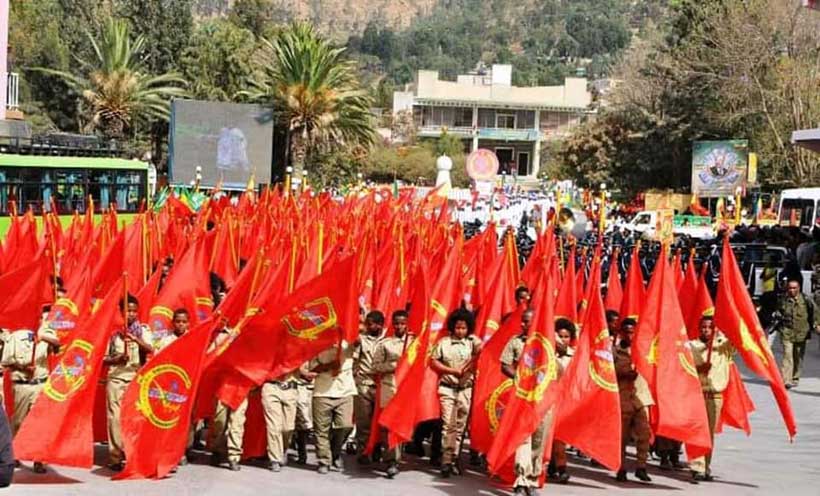Since 1970, there has been an increase in intra- and inter-war conflicts in Ethiopia. Due to unionists’ continued involvement in state-making against secessionists and secessionists on going war with unionist to forge their own sovereign states.
Accordingly, the unionist state-making by war has been achieved through legitimate exploitation of resources, legitimate use of violence, and coercive systems. Conversely, the secessionist groups, such as the Oromo Liberation Front (OLF), the Tigray People’s Liberation Front (TPLF), and the Eritrean People’s Liberation Front (EPLF), have been using illegal violence, illegal compulsion, and plundering of resources to wage war on the Unionists (Ethiopian governments) for state making.
As a result, Eritreans build states that are recognised both domestically and internationally. Since 1993, Eritrea has united as a sovereign nation in the Horn of Africa, while others have been waiting for a safe political landscape.
State making and War making between unionists and secessionists since 1974
The long-monarchical form of government was replaced by its military force (later called Derg), in the middle of 1974, in the wake of a revolution and violence instigated by elites who desired state making along linguistic and ethnic lines.
Mengistu-Hailemariam was appointed chairperson of the armed forces in the same year. He paved his way to absolute and centralized power, and he imposed his version of a dictator-based Marxist revolution on the Ethiopian people. Ethiopia was transformed into an absolute and central military dictatorship.
The economy and the economy sectors were monopolized by the government. This helped Mengistu to assemble the biggest fighting force in sub-Saharan Africa and create a centralized, strong state.
However, Eritrean’s, Tigray’s, and Oromo’s elites claim to their own sovereign state, the Ethio-Somali elite’s interest in integrating Ethiopian-Somali with the Islamic State of Great Somalia, and the patrimonialized military dictatorship institutions of the Derg created a safe political landscape for rebel groups and secessionists to challenge Derg.
As a result, the Derg actively participated in war with secessionists and rebel groups. During the war of state building and preservation (Derg as Unionist and state builder and preserver) and state making (rebel groups and secessionists), extraction of resources, violence, mass murder, bloodshed, ethnic cleansing of Amhara ethnic groups and other atrocities occurred.
Secessionists TPLF and EPLF created an alliance and fought with Derg from 1975–1991. Following this, TPLF, which had an ethnic base as an organized means, committed many wars with Derg and organized crime to create the Tigray Sovereign State.
Similarly, EPLF had the Eritrean people’s support. The Eritrean people exhibited support for EPLF by becoming non-diligence for respecting and being responsible for central government economic and political institutions.
They did not pay tax or revenue to the central government. They were not submissive to the political delegation of the central government. They provided manpower and logistics for EPLF. This made EPLF a strong and active violence agent against institutions and individuals that belong to the central government.
In addition, OLF (1975–present) and the Ogaden National Liberation Front (ONLF) (1984–present) also joined the struggle with Derg unilaterally. ONLF fought with Derg to integrate Ethiopian-Somali with the Islamic State of Great Somalia, and OLF was at war with Derg because of its interest in creating the great sovereign state of Oromia (Cush) under the Gada political system.
Since the 1970s, OLF, which is organized in the name of the Oromo ethnic group, has been taking part in organized crime, organized genocide, looting of resources, etcetera, against non-Cush peoples to introduce the great sovereign state of Oromia (Cush) under the Gada political system, but its counter-ONLF became a passive violence maker and left the state-making agenda after the collapse of Mohammed Siad Barre’s regime of Great Somalia in 1991.
After 17 years of struggle, in 1991, the TPLF took on political power over Derg to build the state of Ethiopia after the civil war. However, TPLF had a long plan for the state-making of Tigray by extracting resources from Ethiopia, developing its financial power, forging a Tigray elite-dominated political and military system, adopting ethnic federalism, and targeting individuals and religious institutions like Orthodox-Christianity that were propagating unity in Ethiopia.
Anyways, even though its former alliance, EPLF, made Eritrea a sovereign and autonomous state in 1993, until its plan was achieved from 1991–2018, TPLF controlled economic and political leadership under the Ethiopian People’s Revolutionary Democratic Front (EPRDF).
It gave a ceremonial delegation to Ethiopian ethnic groups in the political apparatus of Ethiopia. It became unionist and sustained the state of Ethiopia with weak ethnic-based political institutions.
However, on the eve of 1991, the TPLF had been waging war with the other secessionist group, OLF. OLF is interested either in reshaping the state building of Ethiopia into Cush political entities or to make the Sovereign State of Oromia (Cush), but this could put hurdles in the way of the TPLF’s long-term plan. Accordingly, TPLF fought with OLF until 2018.
In addition, TPLF fought with other internal rebels in Amhara National Regional State who questioned TPLF’s political system as Abyssinian state’s destruction. Dealing with this, during its fight with OLF and other internal rebels, TPLF committed violent crimes, killed civilians, committed rape, made arbitrary arrests and subjected detainees to cruel treatment and torture in the Amhara and Oromia regions between 1991 and 2018.
In 2018, as a response to intensifying crises against the TPLF, the Ethiopian government underwent competitive but peaceful internal reform. After internal reform, the EPRDF, which was a TPLF-dominated regime, was replaced by a new political group that identified itself as the Prosperity Party and claimed it to be a political party with new state making thinking (Synergy in English and Medemer in Amharic).
As a result of the reform, TPLF officials left Addis Ababa and have made Mekelle, the capital of Tigray National Regional State, their political center. Then they have turned from weak state builders of Ethiopia to war makers for the state of Tigray. They have organized youths and manipulated the resources of Tigray Regional National State to wage war with the Federal Government of Ethiopia’s ruling party, Prosperity Party.
The war that began in 2020 spread to other regions, attracted a number of ethno-political players, resulted in widespread violence and devastation, and was put to an end in 2022 with the Pretoria peace deal. But the TPLF has been waging war once more since April 2024 by demonstrating zero tolerance for the Pretoria deal, which was concluded on November 2, 2022.
Ways out
Since April 2024, TPLF has been controlling Raya. Raya has been the major dispute center, and it has been under TPLF authority. Since lands like Raya were annexed to Tigray National Regional State prior to the Federal Democratic Republic’s (FDRE) Constitution of 1995 being adopted, a political decision must be reached to resolve the conflict over territories and lands in order to ensure long-term peace in the Horn of Africa, Tigray, and Amhara. Furthermore, rather than continuing to wage war in order to defend Tigrayan state-making, it is time to comply with Article 39 of the 1995 FDRE Constitution, which grants self-determination up to secession if the Tigray peoples exhibit a desire to depart Ethiopia.






